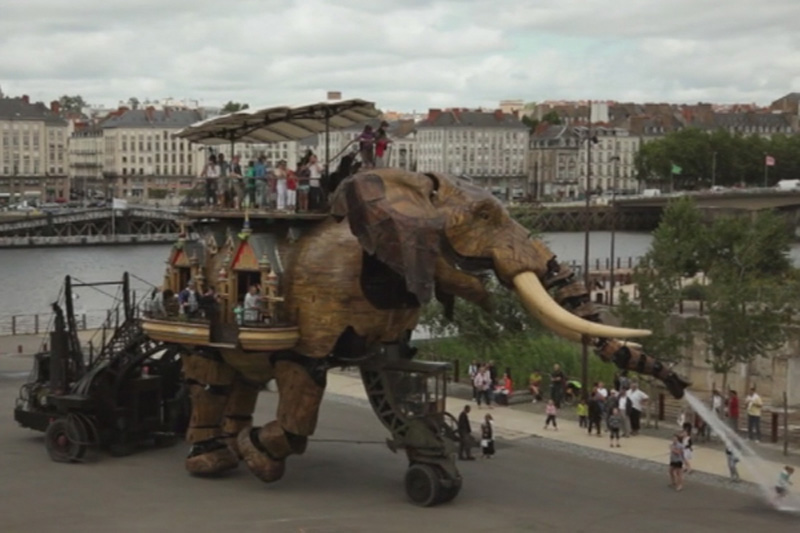
Vera Horváth
Film: Machines of the Isle of Nantes (Dominique Deluze, 2013, ’52)
Friday 6 March – 21:00
The old industrial port of Nantes was built on Île de Nantes, the last major island of the Loire before it runs into the Atlantic. The last boat left the port in 1987, closing down a page in the city’s history. The function of the industrial port was taken over by the ocean shore complex of Sainte-Nazaire, and the shipyards of Île de Nantes lost their function and fell into decay.
The city council could not find new investors for the area, so it decided to let the buildings free of charge for community and cultural purposes, to prevent urban decay. Among the newcomers was Royal de Luxe, a mechanical marionette street theatre company, who used grandiose creations – giant humans, animals and monsters – to shake up street audience, and give them a short break from reality. Their shows swiftly gained popularity among the Nantais. In 1989 the company was given a 10,000 square meter hangar on the island, which allowed them to prepare a permanent gallery with large scale artwork.
The company active to date, La Machine, was established in 2007, and be-came a stable of Nantes cultural life. The city of Nantes began the regeneration of the island, a project partly based on the success of La Machine, and allocated nearly 5 million euros to support the creation of the company’s “zoo” of mechanical creatures. The city council saw an opportunity in the high artistic quality and popularity of the shows: they set out to create a community and cultural space that is fit to popularize culture, and is able to bring art into the everyday life of the citizens of Nantes. Of course, the project was also in-tended to stimulate tourism, and to improve the city’s perception: to rebrand it as a place of creativity and art, instead of a shrinking post-industrial hub. The regeneration project runs until 2023, although the council already sees it as a great success. The Machine Gallery is vastly popular among the Nantais, which allowed the city to renew most of the island’s area, establishing parks and playgrounds. Besides La Machine, the island has attracted other art companies, hospitality services, a Fine Arts faculty, and real estate developers.
Members of the company quote the imaginary world of Jules Verne and the blueprints of Leonardo da Vinci as inspirations for their work. The steampunk style of the giant creatures, their visible metal structures and finely carved wood, matches the post-industrial old shipyard buildings beautifully; the same way their creators, working with power tools in protective clothing, have found an ideal site in the renovated industrial complex. The audience walking around in the company’s hangar building does not only admire the giant fauna (chameleon, flying fish, turtle, and the 12 metre high Great Elephant, set to carry 49 passengers at a time). They also get the opportunity to control or ride them. According to creator and artistic director François Delarozière, their mechanical structure serves as a counterpoint to the virtual nature of the post-modern era: the viewer becomes a participant, and has to use the physical movement of his own body in order to control the movements of the creature.
